Harman Stove Company MARK III, Mark I, MARK II User Manual
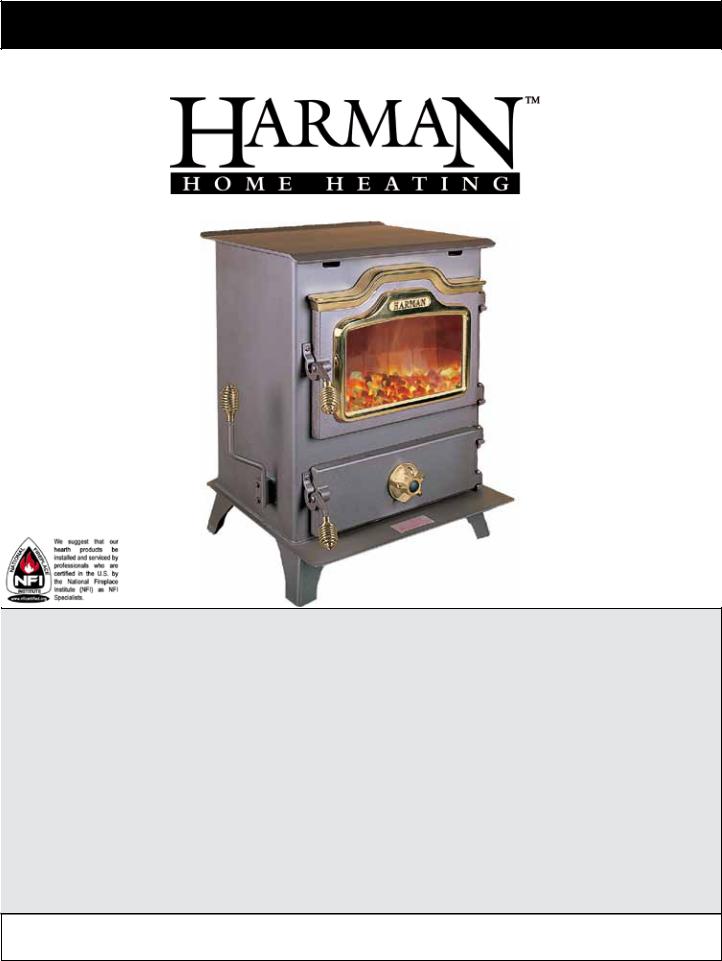
Installation and Operating Manual
Magnafire Series Coal Stoves - Mark I, II, and III
 R4
R4
SAFETY NOTICE
PLEASE READ THIS ENTIRE MANUAL BEFORE YOU INSTALL OR USE YOUR NEW ROOM HEATER. FAILURE TO FOLLOW THESE INSTRUCTIONS MAY RESULT IN PROPERTY DAMAGE, BODILY INJURY, OR EVEN DEATH.
APPROVED FOR USE IN THE U.S. AND CANADA
IF THIS HARMAN STOVE IS NOT INSTALLED CORRECTLY, A HOUSE FIRE MAY RESULT. FOR YOUR SAFETY, FOLLOW INSTALLATION DIRECTIONS PRECISELY.
CONTACT LOCAL BUILDING OR FIRE OFFICIALS ABOUT RESTRICTIONS AND INSPECTION REQUIREMENTS FOR YOUR AREA.
CONTACT YOUR LOCAL AUTHORITY (SUCH AS THE MUNICIPAL BUILDING DEPARTMENT, FIRE DEPARTMENT, FIRE PREVENTION BUREAU, ETC.) TO DETERMINE THE NEED FOR A PERMIT.
CETTE GUIDE D’UTILISATION EST DISPONIBLE EN FRANCAIS. CHEZ VOTRE CONCESSIONNAIRE DE HARMAN HOME HEATING.
Save These Instructions |
#3-90-70746 |
|
|
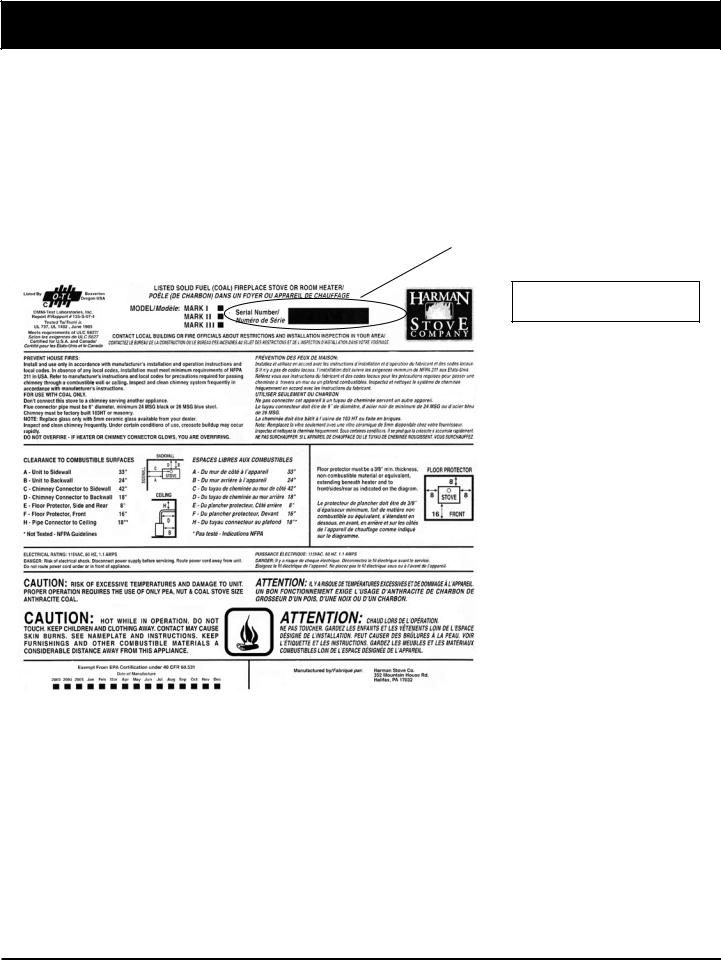
Introduction
Thank you for purchasing a Harman Magnafire coal stove. The Magnafire series has been designed and built to last. Whether you’re heating a room or heating your whole house, you’ve made the right choice. Please read this entire instruction manual before attempting to install or operate your new stove. If you have further questions regarding your new stove, contact your Harman dealer. Follow these instructions and you will have many years of warmth and comfort enjoying your new coal stove.
If you are a first-time coal burner, keep in mind that you will not have instant success with maintaining a fire. No one does. Following these instructions should help you with the basic principals.
Please copy your serial number, from the label on the back of your stove, to the box below.
Listed by: OMNI-Test Laboratories, INC
Report # 135-S-07-4
THis appliance is also approved for installation into a shop.
Safety Notice:
Stove is hot while in operation. Keep combustibles such as furniture, fuel, and draperies at least 36 inches away from the appliance.
Do not leave small children unattended while in the room with this heater.
Always wear gloves when attending to the stove.
This stove is not an incinerator. Do not burn garbage, painted or treated wood, or flammable liquids like gasoline kerosene, or engine oil.
Magnafire Series Coal Stoves |
3 |

Index
1.Safety Considerations - Warnings to operator of possible dangers, fire hazards and cautions.
1.1Keep children away -- may cause serious burns
1.2Fuel/Firing Warnings
1.3Curing Paint
1.4Mobile Homes
2.Assembly & installation
2.1Unpacking and Inspection Of Parts
2.2Locating The Stove
2.3Assembly
2.4General Information
3.Venting
3.1Types of Chimneys
3.2Common Chimney Problems
3.3What To Do If You Have A Problem
3.4Chimney Details
4.Grates
4.1Grate System and Controls
5.Operating Instructions
5.1Starting a Fire
5.2Loading Fuel
5.3Increasing Heat From a Low Fire
5.4Shaking Ashes
5.5Ashes and Ash Removal
5.6Safety
6.Preventive Maintenance Instructions
6.1Periodic and Everyday Maintenance
7.Optional Hot Water Coil
8.Warranty Information
9.Service Parts Diagrams
4 |
Magnafire Series Coal Stoves |
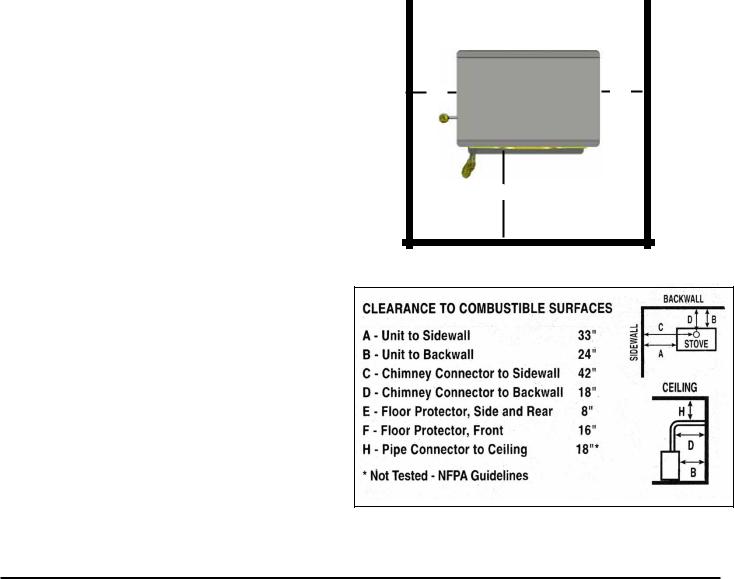
Installation |
||||
|
|
|
|
|
1. Safety Considerations: |
2. Assembly & Installation: |
|||
1.1 KEEP CHILDREN AWAY - MAY CAUSE |
|
2.1 UNPACKING AND INSPECTION OF |
||
SERIOUS BURNS. |
PARTS. |
|||
CAUTION: All surfaces of the stove are hot while in |
Inspect the stove for any visible damage. The blower |
|||
and the shaker handle are packaged inside the stove. |
||||
operation. Do not touch. Keep Children Away. Wear |
|
2.2 Locating The stove. |
||
gloves while tending stove. Serious burns will result if |
Locate the stove as close to the chimney or flue as |
|||
special care is not taken. |
possible while adhering to the recommended clear- |
|||
1.2 Fuel / Firing Information. |
ances to combustible material. Safe stove clearance |
|||
to combustible walls is 24” to the rear of the stove, |
||||
DANGER! FIRE HAZARD! DO NOT USE CHEMI- |
and 33” to the sides of the stove. In a corner installa- |
|||
CALS OR FLUIDS TO START OR “FRESHEN UP” |
tion, you need 24” to the side walls. Clearance to the |
|||
A FIRE. SEVERE BODILY INJURY AND/OR A FIRE |
front of the stove, for furniture, etc. is 36” |
|||
IN THE HOME MAY RESULT. DO NOT BURN GAR- |
|
Floor protection, for a combustible floor, must |
||
BAGE, GASOLINE, THINNERS, KEROSENE, OR |
be a minimum of 3/8” thick non-combustible material. |
|||
FUEL OIL, ETC. AN EXPLOSION, A HOUSE FIRE |
The floor protector should extend 8” to either side, |
|||
OR PERSONAL INJURY COULD RESULT. KEEP ALL |
and 16” in front of the stove. Floor protection should |
|||
SUCH LIQUIDS WELLAWAY FROM THE STOVE |
also be under any horizontal sections of flue pipe. |
|||
WHILE IN USE. |
|
|
|
|
|
|
|
|
|
This heater is approved for burning coal only. |
|
|
|
|
|
8” |
|||
Use of any other fuel, except for the purpose of coal |
|
|
|
|
|
|
|
|
|
ignition, is a violation of U.S. law. |
|
|
|
|
When and if the chimney pipe or connector |
8” |
8” |
|
|
|
reaches 500˚ f. (maximum temperature), the stove is |
|
|
being over-fired. It is recommended that you use mag- |
|
|
netic thermometers on the stove and flue connector, |
|
|
to ensure safe operation. |
|
16” from glass |
|
|
This stove consumes air when it is burning.
If your house is especially tight, It is advisable that a Floor Protector nearby window be opened slightly while burning the
stove.
Information in this manual is manufacturer’s recommendations. If there is a discrepancy between these recommendations and your local code requirements, you must follow local codes.
1.3 CURING PAINT.
During the first few hours of burning, a blue smoke will be observed rising from the painted surfaces of the stove. This is the paint being cured, and will disappear over time. Increase the amount of fresh air in the room during this initial break-in period. This may be achieved by opening doors or windows.
1.4 Mobile Homes.
This stove is not approved for use in mobile /manufactured homes.
Magnafire Series Coal Stoves |
5 |
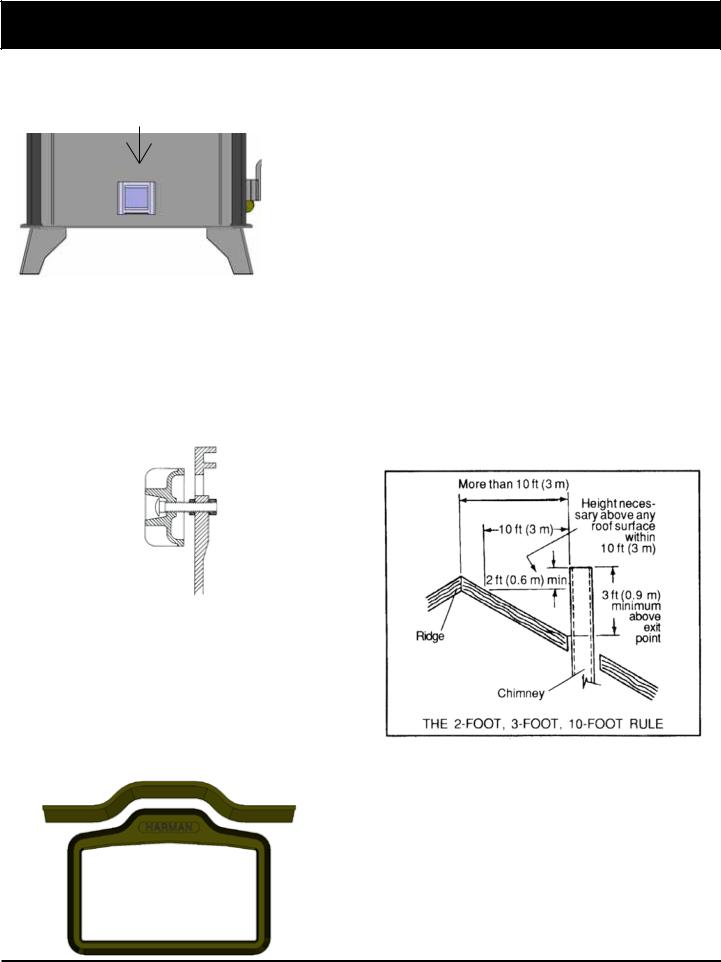
Installation
2.3 Assembly.
Slide the blower into the slotted bracket on the rear of the stove. The blower will rest at the bottom of the slot.
The shaker handle bolts onto the shaker block using the bolts and lock washers provided.
The draft control is bolted through the hole in the center of the ash door as shown below. The knob should spin freely and open to a distance of about 1/4 inch from the door surface, while being able to close against the face of the door.
The viewing glass is installed between the door and the window frame. The glass gasket is installed only on the sides of the glass panel. The top and bottom of the glass are open to provide air-wash and secondary air to the firebox. The glass frame is secured to the door with four bolts.
The Mark II and Mark III also have a top trim piece which bolts onto the top of the door.
Be sure the frame bolts and trim bolts are secured.
2.4 GENERAL INFORMATION.
Installation Checklist:
A.Have your stove installed by a trained installer. Preferably one who is certified by the National Fireplace Institute or similar certification agency.
B.Before starting Installation, check for proper clearance to combustibles where the stove is going to be located.
C.Never vent a solid fuel burning appliance into a flue serving another appliance.
D.Have the chimney inspected and thoroughly cleaned. Inspect that it is a Class “A” chimney either masonry or factory built. If it is a manufactured chimney, ensure that it is installed as per the manufacturers requirements. Be sure that the chimney is tall enough. Solid fuel chimneys fall under a general rule, 16 ft. minimum height, 2 ft. taller than anything within 10 ft., and 3 ft. above where it passes through the roof line. The chimney must be capable of a minimum
.06 inches of water column of draft when the stove is burning.
E. Limit the amount of connector pipe. Position the stove as close to the flue as possible. (8 ft. or less) No more than two 90° elbow fittings should be used.
Any horizontal connector pipe should have at least 1/4 in. of rise per foot in length. A barometric damper may be installed to prevent excessive or erratic draft.
MANUAL DAMPERS OR “HEAT SAVERS” MUST NEVER BE INSTALLED IN THE FLUE PIPE. IMPROPER OPERATION COULD RESULT IN DEATH.
6 |
Magnafire Series Coal Stoves |
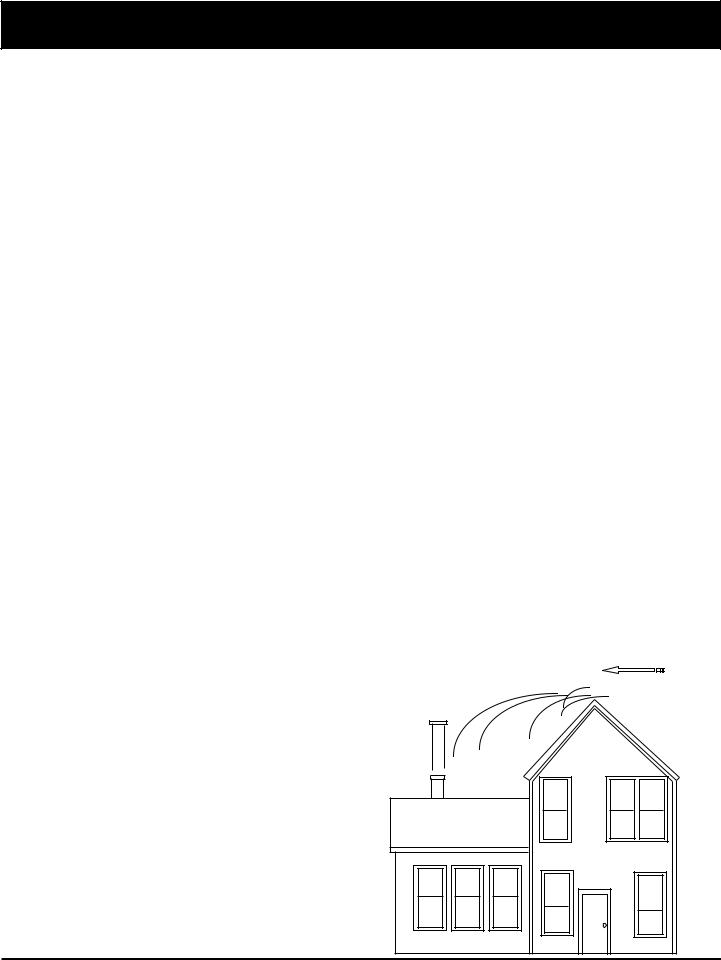
Venting
Where an existing chimney is used, it must be large enough to provide a draft adequate for removing the gaseous products of combustion. The cross-sectional area of the chimney must be at least 25 percent greater than that of the connector. As a general rule, common 8” X 8” flue liner has an actual interior crosssectional area of 42 to 49 inches. This is adequate for a 6 inch stove connector, which matches the appliance flue collar.
Important! The connector pipe must be constructed of 24 gauge material or thicker.
3. Venting & Chimneys:
3.1 TYPES OF CHIMNEYS
The chimney is one of the most important, yet the most neglected and misunderstood portion of any solid fuel burning appliance installation. Do not connect your stove to a chimney flue that already serves another heating device.
The stove must be connected to its own flue. A minimum 8” X 8” is necessary for proper operation.
Under no circumstances should a manual flue damper be installed in the smoke pipe between the stove and the chimney.
Caution! the chimney must be a “class A” chimney in good working condition. the use of aluminum “type b” gas vent for solid fuels is not only un-safe but it is prohibited by the national fire protection agency (nfpa) code.
There are three types of “Class A” chimneys;
1)Masonry with a tile liner, including brick, block, stone, etc. It must be supported by a groundlevel foundation.
2)Insulated “Class A” manufactured chimney, listed and certified by a national test agency.
3)Triple-walled metal “Class A” chimney, listed and certified by a national test agency.
If your masonry chimney has not been used for some time, have it inspected by a qualified person (building inspector, fire department personnel, etc.). If a listed and certified manufactured chimney is to be used, make certain it is installed in accordance with the manufacturers instructions and all local codes.
A coal stove can perform only as well as its venting system will allow it to.
3.2 common chimney problems
In order to have a properly operating heating system, the chimney needs to be capable of providing sufficient draft. The minimum required draft is .06 inches of water column (WC). To measure the draft, drill a hole in the connector pipe and attach a draft meter. First, check the draft above the barometric damper (if installed). Then check it below the barometric damper and make your damper adjustment to where it opens to prevent the draft from going higher than the .06
in WC. If the chimney is incapable of supplying the necessary draft, it will need to be improved. Whether it needs to be raised to a taller height, a flue liner installed, or a different style of cap placed on the top, the improvement method will need to be determined.
Reasons for insufficient draft;
A)Leaking chimneyAir leaking in around a loose fitting cleanout door, joints or seams in connector pipe are not secured properly, cracks or other defects in masonry.
B)Improper chimney height - Chimney does not extend to a sufficient height above the roof line. (Remember the 3 ft.-2 ft.-10 ft. rule)
C)Obstructions in the chimney - Make sure the chimney has been cleaned. Different animals have been known to build nests in chimneys.
D)Trees or other topographical barriers - Trees that are taller than the house can cause the air currents to flow downward over the peak of the roof. This would lead to a down draft effect on the chimney. This can also be caused by adjacent buildings or fixtures. It could even be from a different peak on the same structure.
Wind direction
Magnafire Series Coal Stoves |
7 |
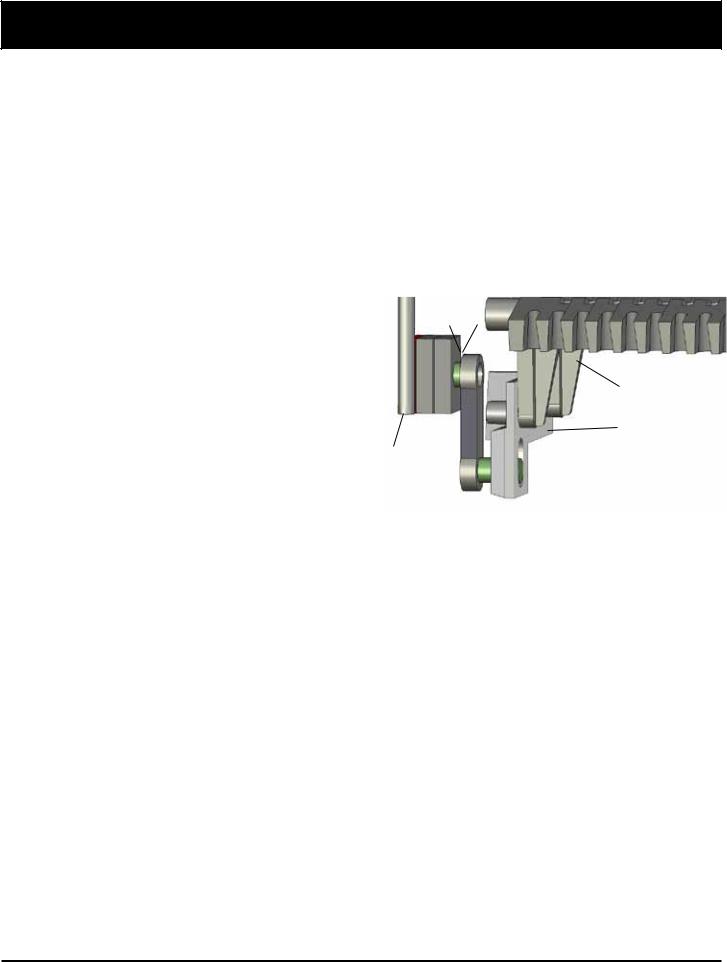
Venting & Grates
E) Improperly sized flue - Too small of a chimney is |
|
4. Grates |
|||||
incapable of moving the volume of air necessary. Too |
|
||||||
large of a flue could have trouble warming up to cre- |
|
4.1 GRATE SYSTEM AND CONTROLS. |
|||||
|
The Grates are made of heavy-duty cast iron. The |
||||||
ate the necessary upward flow. |
|
||||||
|
function of the grate system is to support the coal |
||||||
F) Chimney offsets - Offset chimneys should be |
|
||||||
|
while allowing air flow through the fire. The grate sys- |
||||||
avoided if possible. Not only can the offset affect draft, |
|||||||
tem also allows removal of the ashes by shaking them |
|||||||
it is also a place for debris to collect over time. |
|
through the grates. |
|||||
G) Too many elbows - The flue connector has more |
|
||||||
|
The grates are removable without the use of tools, |
||||||
than two elbows in it. Sometimes, depending on |
|
||||||
|
once the fire bricks are removed, the grates simply |
||||||
overall chimney performance, one elbow could be too |
|
||||||
|
lift out. Lift the right end higher to disengage from the |
||||||
many. |
|
shaking link. To re-install the grates, lower them, one |
|||||
H) Vent sharing - No more than one heating appliance |
|||||||
at a time, left end first, be sure the grate hooks into |
|||||||
shall vent into a single flue. |
|
the grate link as you drop it into place. |
|||||
|
|
|
|||||
|
|
|
|||||
THE MOST IMPORTANT THING TO REMEMBER |
|
|
Stove body |
||||
ABOUT CHIMNEYS IS THEIR NEED FOR MAIN- |
|
|
|
|
|
|
|
TENANCE AND CLEANING. IF A CHIMNEY IS NOT |
|
|
|
|
|
|
|
CLEANED ON A FREQUENT BASIS, IT WILLAF- |
|
|
|
|
|
|
|
FECT DRAFT, AS WELLAS BE A CONTRIBUTING |
|
|
|
|
|
Grates |
|
FACTOR TO A POTENTIAL CHIMNEY FIRE. |
|
|
|
|
|
||
|
|
|
|
|
|
||
3.3 what to do if you have a problem. |
|
|
|
|
Grate Link |
||
If you have a chimney fire: |
|
Shaker Handle |
|||||
1. Be sure everyone is out of the house. |
|
||||||
|
|
|
|
|
|
||
2. Call the fire department. |
|
|
|
|
|
|
|
3. Close the draft control on the ash door and |
|
|
Shaker Bar |
||||
make sure both doors on the stove are closed |
|
|
|
|
|
|
|
|
|
|
|
|
|
||
and latched. |
|
Your grates will last forever, as long as you keep your |
|||||
4. Do not put water on the fire, this will cause un- |
|
ashes cleaned out of the stove. When ashes are left |
|||||
necessary damage to the stove and flue. |
|
pile-up against the grates, the air-flow is blocked. With |
|||||
5. Have the chimney inspected and repaired prior |
|
no air flow through the grates, they will begin to sag |
|||||
to building another fire. |
|
from the intense heat. |
|||||
Smoke puffs out of stove; |
|
The grates are designed to accommodate three differ- |
|||||
|
ent sizes of anthracite coal. Pea is defined as being |
||||||
A) Check previous suggestions for insufficient draft. |
|
able to fit through a round screen hole of 9/16” to 7/8”. |
|||||
B) Check draft control for proper operation. |
|
||||||
|
Nut or Chestnut is defined as being able to fit through |
||||||
C) Chimney may be too low. Increase height. |
|
||||||
|
a round screen hole of 7/8” to 1½”. Finally , Stove coal |
||||||
D) Add more fresh air to the room. Your home may be |
|
||||||
|
which is 1½” to 2½” in size. Pea or Nut you’ll find work |
||||||
so tight that there is not enough oxygen getting to the |
|
the best for starting a fire, while all three sizes burn |
|||||
fire. |
|
just as well. |
|||||
E) Remember, open the draft control and crack the |
|
||||||
|
The external shaker handle allows for greater safety |
||||||
door open slightly before reloading or checking the |
|
||||||
|
from burns, and the convenience of needing no extra |
||||||
fire. |
|
||||||
|
tools. |
||||||
F) Check the ashes. The ash pan and firebox may be |
|
||||||
overloaded with ashes.
G) Check the chimney cleanout door to ensure it closes properly.
8 |
Magnafire Series Coal Stoves |
